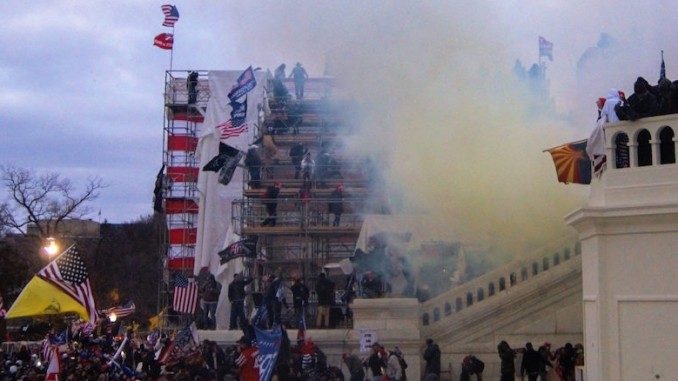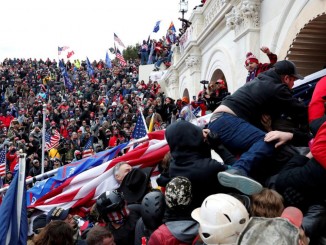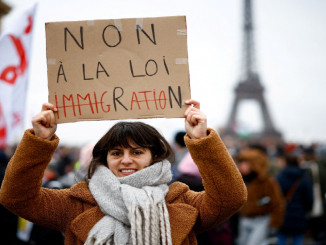
Introduction
The storming of the US Capitol last month by crowds of protesters was a stunning display of defiance and anger. Fueled by a false belief that the presidential election was being stolen from them, and exhorted by Trump’s call to march to the Capitol, they took matters into their own hands, invading the halls of the Capitol building and attempting to defend so-called democracy by force. Clashes between protestors and capitol police, who in some cases were complicit and let the protestors in, resulted in several deaths. For the most part however, the protesters succeeded in overwhelming security barriers and in delaying Congress’s certification of the electoral college votes for the president. It was a spectacle that caught the world by surprise.
But who were these protesters? Where did they come from and why were they there? It’s not difficult to notice that some of those that participated in and led the Capitol takeover belong to the far-right. They can be easily identified as members or supporters of nationalist, white supremacist, militia, fascist, and conspiracy-oriented groups. Followers of QAnon – a conspiracy theory that alleges elite Satan-worshiping pedophiles are trafficking children and eating them – could be seen there holding various signs and symbols supporting the conspiracy. Neo-Nazis as well as right-wing militia groups like the Proud Boys, Three Percenters, and Oath Keepers were there as well. But the overall presence of the far-right appeared to be small with only about 10% of the over 200 people arrested so far for participating in the riot having known ties to these groups and ideologies.
Many of these far-right groups have been around for years. However, they largely remained out of the spotlight, operating and transmitting their views mostly through local conferences, online forums, and social media. Far-right public rallies were infrequent, small, and rarely made national headlines, and were often met by bigger counter-protests. For the most part, their reactionary views failed to find a strong foothold with many people and their entrance into mainstream politics remained largely out of reach.
Despite this, their following has undoubtedly grown in the past few years, emboldening them to organize more brazen public demonstrations, from the “Unite the Right” torchlight march in Charlottesville, Virginia several years ago to the takeover of the Michigan state capitol by armed protesters against COVID-19 measures. Their growing presence in the streets and on mainstream news outlets is not easy to ignore.
Growth of the Far-Right
The increased appearance of the far-right can be attributed to numerous factors. The emergence of the Black Lives Matter movement in 2013 along with the resurgence of racial justice protests that drew an estimated 26 million people following the killing of George Floyd last year, sparked a renewed far-right response. To them, these large demonstrations were a threat not only to the status quo and social order but were also in direct political opposition to their views. In response, far-right rallies were held in numerous cities across the country, some which led to violent or even deadly clashes when antifascist protestors mobilized to prevent the far-right from holding public demonstrations.
These far-right rallies were also driven in part by the false belief that BLM demonstrations were being organized by anti-fascists and Marxists who they claimed posed an authoritarian threat to the country. In addition, efforts by BLM activists and others to stop the hateful rhetoric of these groups, as well as calls to “defund the police” and have confederate flags, symbols, and statues removed from public places, pushed the far-right’s narrative of victimization. They have tried to use this situation to say that their freedom of speech, history, and cultural identity was being taken away from them, which gained them further attention and some support.
The start of the COVID-19 pandemic last year also led to new ground for the far-right. Measures to control the spread of the virus including implementing state-wide lockdowns and requiring the use of masks in public places became a rallying cry for them. Their message that the virus was a hoax and that these actions were authoritarian and infringed on their personal liberties resonated with some people who joined in protests to “reopen” America in states throughout the country.
Trump
There is also one thing that has not only had a large influence in their growth but has also become a unifying icon of their movement: Trump. The rise of Trump, who used much of the same divisive rhetoric during his presidency as they do, transformed the political landscape for them. Trump’s right-wing nationalist platform has provided an opportunity for them to catapult their groups and views into mainstream politics and attract a new range of followers, including among those that make up Trumps base, which has led to an increase in far-right mobilizations and activities. As a result, many of them who had long remained in the margins of society have come to view Trump as “their” president, a leader who can relate to their beliefs and is promoting their interests.
And Trump did not let them down. Even before taking office, he emerged as a leading proponent of many of these groups and their twisted views. He pushed the “birther” conspiracy theory which falsely claimed Obama had been born outside the US and therefore was not qualified to be president and has shown support for QAnon, who see him as a savior of the nation. He has shown his support of far-right groups through remarks he has made like referring to white supremacists that organized the “Unite the Right” rally, where one person was killed, as “very fine people” or directing the Proud Boys to “stand back and stand by” during the 2020 presidential debate. At his rallies, he continuously encouraged his supporters to commit violence against protestors, and after losing the election, he became the main spreader of the false claim that the election was a fraud, agitating his followers and urging them to defend democracy at all costs, which culminated with the occupation of the Capitol building.
What is the Far-Right and What Are its Ideologies?
The far-right is hard to generalize since it can be characterized in many different ways. The groups at the forefront of the occupation of the Capitol are part of what is known as the far-right. They are groups that often openly support white supremacist, anti-Jewish, Nazi or other fascist views, and are organized on that basis.
Far-right political groups and ideas have long been part of the political landscape in the US. Groups like the Ku Klux Klan have helped to maintain racial terror and white supremacy in the South since the end of the Civil War. More recently, the bombing of the Oklahoma City federal building in 1995 was carried out by military veterans radicalized by far-right ideologies.
There are a variety of ideologies that exist within the far-right today. Many groups have anti-government sentiments and believe in challenging any violation they feel the federal government is committing against their personal rights. These sentiments are often mixed with anti-communism, racism, anti-semitism, and white supremacist ideas. They also often contain belief in conspiracy theories that government elites are collaborating with these sections of society to destroy a vague notion of traditional American life and culture. But despite their criticisms of a system that supposedly undermines and attacks their existence, far-right groups are staunch defenders of it.
Many far-right ideas in the U.S. are also heavily influenced by Christian Evangelical thought, which has always played a role on the political right-wing in American politics. This contributes to the notion in far-right politics that America should be a White Christian society at the expense of other social groups.
More recently, far-right groups that have become popularized in the Trump era have been influenced by the “alt-right” and aspects of the “militia movement.”
The “Alt-Right”
The alt-right is the loosely connected far-right and white nationalist movement that has grown online and in some ways has attempted to “rebrand” their movement for the new generation by making it seem more modern and professional compared to older stereotypes of white supremacy and Neo-Nazism such as the Ku Klux Klan or “skinheads.” Groups like the Proud Boys and neo-Nazi groups such as the “Groypers” are a part of the alt-right.
Far-Right Militias
The “militia movement” has deeper origins in American life going back decades. It is represented today by groups such as the Oath Keepers and the Three Percenters. The militia movements have their origins in armed, libertarian political groupings, particularly in more rural areas of the U.S. Their politics are historically mixed, ranging from wanting to defend their lifestyle and civil liberties such as gun rights and land use from government intervention, to more violent, conspiratorial, and racist views.
Militia politics have been shaped by the marginalization of rural America. Rural areas have been decimated economically by large financial interests such as the agribusiness industry, while other areas have suffered because of divestment from resource extraction industries that once offered good-paying jobs. This has led to great poverty and anti-government sentiments that organized right-wing groups have been able to exploit and organize from.
Funding and Political Support
The far-right relies primarily on self-funding, with some support from wealthy donors. One of their most prominent donors in the recent period has been the Mercer family, which helped create the right-wing Breitbart News and invested heavily in Trump’s 2016 campaign. The Mercer funding helped Trump’s campaign carry out a sophisticated strategy to target voters with social media advertisements in areas where the votes that would swing the electoral college were tightly contested. This strategy helped deliver Trump’s electoral victory despite losing the popular vote by almost 3 million votes. More recently, they funded the creation of the right-wing social media platform Parler, which was marketed as an alternative to Twitter and Facebook and has been a platform for far-right social media influencers and spreading conspiracy theories.
In addition to the Mercer family, there are a network of “shadow” political action committees (PACs) which have given money to far-right media companies, think tanks, and front groups that help fundraise for event such as the “Save America” rally in Washington D.C. on the day the capitol was stormed. These donor networks also spend big money on pro-Trump Republican candidates to move the Republican party further to the right and advance conservative economic agendas.
This has the effect of creating a rightward-moving political environment which creates the backdrop for far-right groups and ideas to move more into the mainstream. One example of such donor networks is those led by the Koch brothers. While not directly linked to the far-right, they heavily funded the “Tea Party” movement which promoted an anti-liberal and anti-big government agenda to reinforce the idea of local rule against federal intervention in areas such as healthcare. Many “Tea Party” activists have evolved to constitute Trump’s base and others have moved into far-right political circles.
Political candidates linked to the far-right and the Tea Party have succeeded in winning elected office throughout the country at various levels of government. These candidates have been some of the most devoted supporters of Trump and have helped lead the current ideological divisions in the Republican party between more traditional conservatives and the new generation of pro-Trump candidates. An example is newly-elected congresswoman Marjorie Taylor Greene, who has gained media attention for her support of Trump’s election fraud claims and QAnon conspiracy theories. Before Greene was elected, she was a small business woman with little political experience who was a known associate of Three Percenter militia members in Georgia.
Besides these wealthy funding outlets, far-right activists have been primarily self-funded by successfully using the internet and crowdfunding to grow their popularity and influence. “GoFundMe”-like pages, internet chat rooms like 4Chan, and livestreaming are examples of arenas where the far-right has peddled its ideas with some effect.
Who Are Some of These Groups that Stormed the Capitol?
I. Proud Boys
The Proud Boys were founded in 2016 in New York as an organization for “Western Chauvinists.” They have since spread to all 50 states and have gained popularity during the Trump administration through their involvement in street fighting against anti-fascist protestors. They are estimated to have anywhere from 1,000-3,000 people amongst their ranks nationally. They have skillfully inserted themselves within Trump’s base and have tried to cultivate a more mainstream public image of being defenders of traditional conservative/libertarian values and are not a white supremacist organization. They have attempted to publicly reaffirm this via the fact that their national figurehead, Enrique Tarrio, is the son of Afro-Cuban immigrants to the United States. Looking at the social media accounts of Proud Boys members however, it is clear to see that many of them support white supremacy, racist, and anti-Jewish ideas. Photos taken on January 6th outside the capitol show a large group of Proud Boys flashing the “white power” sign on social media. They have helped organize various far-right demonstrations during the Trump administration such as the Charlottesville “Unite the Right” rally and were among the groups who participated in the storming of the capitol. Following the January 6th events, Tarrio was accused of being an FBI informant. There are divisions within the organization over their racial makeup and commitment to white supremacy, and it appears the internal life of their organization is in disarray over this question.
II. Three Percenters
The Three Percenters is an organization that was founded in 2008 that comes out of the militia movement. Their name is based on the false notion that only three percent of the American colonists took up arms against British colonial rule in the American Revolutionary War. Their founding was partially in response to the election of Obama, and the belief that his administration would bring about tyrannical “socialist” policies such as open borders and an end to second amendment rights. They claim several thousand members nationally in the U.S. and have an affiliate organization in Canada. Individuals linked to the Three Percenters have also gained notoriety in the last decade for taking part in armed standoffs with federal law enforcement officials over land dispute issues in Nevada and Oregon.
III. Oath Keepers
The Oath Keepers is another militia-style organization that was founded in 2009 and is composed of current and former members of the armed force, police, and first responders. Their name is derived from the “oath of office” they were sworn to take in which they pledge to defend the Constitution against all enemies – foreign and domestic. They primarily recruit out of law enforcement and military circles. Similar to the Three Percenters, they believe things like an attempt by the government to declare martial law, take away guns, and establish detention camps may be imminent, and that they need to prepare themselves to launch an armed rebellion against the government establishment. Several members of the Oath Keepers that participated in the storming of the capitol worked as private security for Roger Stone, one of Trump’s main political advisors. In the past, members of the Oath Keepers travelled to Ferguson, Missouri during the Black Lives Matter protests to help “keep order” and intimidate protestors. Last year, Stewart Rhodes, the founder of the Oath Keepers, called the George Floyd protests a communist insurrection and the start of a civil war that the Oath Keepers would respond to if Trump did not suppress the movement. They are estimated to have several thousand members nationally.
IV. Neo-Nazis
Since the growth of fascism in Europe before World War II, there have been political movements in the United States that wanted to emulate the powerful fascist parties like the Nazis. There are several key Neo-Nazi trends in the United States right now that are all relatively small. Arguably the most extreme is an organization called the Atomwaffen Division, which consists of small terrorist cells trying to create the destruction of American civilization so that a white ethno-state can emerge from the ashes. There is also the “Groyper” movement which is seeking to operate within Trump’s base and argue for white nationalist perspectives. Finally there have been neo-Nazi organizations called “Identity Evropa” – which was then rebranded as the American Identity Movement – and the Traditionalist Worker’s Party that have been active in the last period. By 2019 however, these organizations seem to have disbanded, with certain activists within them moving into the “Groyper” movement or other organizations. During the storming of the capitol, several known “Groypers” took part in the capitol storming and other Neo-Nazi perspectives were represented, such as the person photographed wearing a “Camp Auschwitz” shirt. It is unclear how many individuals constitute the American Neo-Nazi political movement currently.
V. Boogaloo Movement
The “Boogaloo” Movement is a loose network of extreme-right people online, some of whom are trying to incite a race war in the United States – known within the community as “the boogaloo.” “Boogaloo Bois” often identify themselves by showing up to protests armed in tactical gear and wearing Hawaiian shirts. It is difficult to characterize the size or dominant ideology of the Boogaloo movement at this point given their loose, decentralized nature. From the outside looking in, it seems that the lines are blurred between anti-government views and calling for a civil war that can create a new, white supremacist society.
In the last year individuals openly identifying with the Boogaloo movement have begun to act on their ideas and engage in political violence. One example of this was active-duty soldier Steven Carrillo, who shot two federal law enforcement agents outside the federal building in Oakland during the height of the George Floyd protests over the summer of 2020, and later shot and killed a California Highway Patrol (CHP) officer in an armed standoff in the Santa Cruz mountains.
VI. Ku Klux Klan
The Ku Klux Klan was created in the immediate aftermath of the Civil War to engage in racist terror in the South and oppose Reconstruction. The KKK has been a major force in American politics to maintain racial segregation. While newer “alt-right” white supremacist organizations have come to the fore in the recent period, smaller Klan groupings exist throughout the country and still play a role. It is estimated they have a few thousand people in their ranks and their influence was seen on January 6th through the presence of Confederate flags.
VII. QAnon
Several of those storming the capitol are followers of the QAnon conspiracy, which argues key figures amongst the U.S. government and global elites are engaging in a child sex-trafficking conspiracy, while also engaging in cannibalism and worshipping Satan. They believe Trump’s role as president is to fight against these elites and expose their injustices. They also claim to be receiving anonymous messages from an undercover government official named “Q”, who spreads messages to followers via anonymous internet chat rooms. This conspiracy has spread to other countries such as the UK, Germany, and Japan. It is unclear how many QAnon adherents there are at this point, as it is conspiratorial and not organized. The “QAnon Shaman” is a high-profile adherent who entered the Senate chamber during the January 6th events.
Not All Right-Wingers Follow the Far-Right
While these groups played a major role in the Capitol takeover, we must also recognize not everyone who took part in it or the “Save America” rally before it follows these groups and ideologies. Some were there only to answer Trump’s call to prevent the steal, while others were there more in protest against the deteriorating conditions of their lives. Like most working people across the country, they too find themselves falling into deeper economic and social despair, the result of decades of inadequate wages, rising healthcare and housing costs, lack of jobs, declining social services, and many other things. The crisis they find themselves in, which is being driven by a system that enriches the wealthy at their expense, and the government’s failure to address their needs, has pushed them to the edge. They like many of the 74 million who recently voted for Trump, have become dissatisfied with a system that has brought constant misery and uncertainty into their lives, and with politicians that continue business as usual by defending the interests of corporations above all else. For them, Trump has become their voice, someone who stands up for them and who is fighting the establishment for their interests.
And the far-right is capitalizing on these conditions. They are using people’s anger to attract them to their ideas and fuel their own agendas. Media outlets like One America, Clear Channel, Sinclair Broadcast Group, and others, along with right-wing personalities such as the late Rush Limbaugh, Michael Savage, and Ben Shapiro, serve to further polarize these sections of the population by drawing them towards these reactionary views, often by playing on their evangelical Christian beliefs.
Fighting the Growth of the Right Wing
Though the rising activity of the far-right can be disturbing, we should keep in mind that the main goal of the rallies and clashes we’ve seen so far has been more about publicity than anything else. Many of the far-right groups have made a name for themselves just by hitting the streets to yell, intimidate, and brawl with other activists in hopes of making it on the news. In doing so they have been able to reach a wider audience than they were able to before, but their numbers still remain small.
Nonetheless, we must be ready to oppose any potential threat headed our way from these groups. We have seen by the general response of law enforcement that they are not viewed as a threat to the system, but a force that needs to be kept under control and let loose when it is useful for those in power. The ruling class has an interest in maintaining a political environment with far-right ideas as it helps them divide the population, and when necessary to use these groups to engage in violence against those that begin to rebel or challenge their control. We have seen this in the past with groups like the Ku Klux Klan and more recent violence by far-right activists against BLM protestors, and can certainly expect more in the future. Despite their anti-system and anti-elite rhetoric, their goal is to maintain the status quo and defend the system we live under, and we will need to continue to confront them during movements for our rights, including struggles against racism, police brutality, and to improve the living conditions of working people. Our forces are superior to theirs – even when they are backed by those in power – and we must be prepared to defend ourselves by mobilizing our collective forces against their hate and right-wing violence.
But recognizing and confronting the threat these groups pose will not be enough. We must also identify and eliminate the source that gives rise to these problems – Capitalism. We must fight for and present an alternative system to the millions of people who are becoming increasingly desperate, to have them not look at refugees seeking a better life or those facing the brutal racism of this society as their enemies, but rather to mobilize all our forces against a system of exploitation that is responsible for the conditions we are all facing. In the process, we can not only expose far-right groups for what they really are but can also win over those who could be attracted to their radical rhetoric to the fight to improve all our lives.




